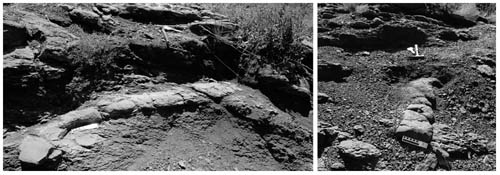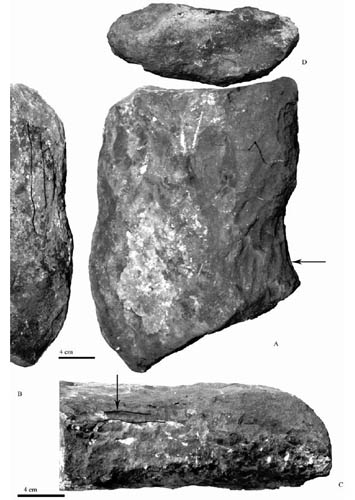Tracing Large Tetrapod Burrows From the Permian of Nei Mongol, China
Pre-Cenozoic terrestrial tetrapod burrows have been found in North America, Antarctica, Morocco, and Poland. These burrows are identified as the production of dicynodonts, cynodonts, therocephalians, therapsid or mammals, procolophon, archosaurs or turtles, although only some of them are based on direct evidence. Dr. LIU Jun, Institute of Vertebrate Paleontology and Paleoanthropology (IVPP), Chinese Academy of Sciences, and his team reported two large burrows from the Naobaogou Formation of Tumd Right Banner, Nei Mongol (Inner Mongolia), China. It marks the first pre-Cenozoic tetrapod burrow from China, and one of the earliest records of tetrapod burrows in the world. The study published in the latest issue of Acta Geologica Sinica (6) shows the fossorial behavior is not limited in small tetrapods in Permian.
Two burrows (A and B) were collected from the base of the third member of the Naobaogou Formation, and the age of burrows could be the Late Permian or late Middle Permian. The host rock is thinly laminated red mudstone, and the burrow infilling consists of fine to medium sand mixed with silt.
Burrow A is curved and seems to be helical in shape, with a ramp angle of around 15°. Its widths are little varied from the proximal to distal ends. It is approximately 160 cm long, 23 cm wide, and 10 cm tall for the preserved cast. Ridges and furrows interpreted as scratch marks, are clearly visible on the distal side of the cast and mostly distribute on the ventrolateral and lateral sides of the cast. Burrow B is similar to Burrow A but it has no clearly ridges and furrows. It is approximately 100 cm long, 25 cm wide, and 11 cm tall for the preserved cast.
The large size and the scratch marks of the burrow casts indicate the excavator should be a tetrapod. Possible excavators of the burrows, based on the fossils known from the Naobaogou Formation, include dicynodont, captorhnid, and therocephalian. The diameter of most tunnels closely matches the body diameter of its excavator. Comparing to the Permian and Triassic burrows from South Africa and Antarctic, researchers suggested these burrows were created by tetrapod slightly smaller than Lystrosaurus.
"Based on the morphology and sizes of two burrows and known tetrapods of the Naobaogou Formation, the burrow should be the production of a therapsid, most likely a dicynodon. It shows the fossorial behavior is not limited in small tetrapods in Permian", said lead author Dr. LIU Jun of the IVPP, "These burrows also indicate a seasonal climate and this area was semiarid or arid during that time."
This work was funded by 973 Program of China, National Science Foundation of China, and Chinese Academy of Sciences.

Fig.1. Two burrow casts in the field. Left: Burrow A (IVPP V18605); Right: Burrow B (IVPP V 18606). Scale bars equal 10 cm. (Image by LIU Jun)

Fig.2 One distal block (Burrow A) in dorsal (A), ventral (B), lateral (C), and proximal (D) views, arrows point the scratches. (Image by LIU Jun)

